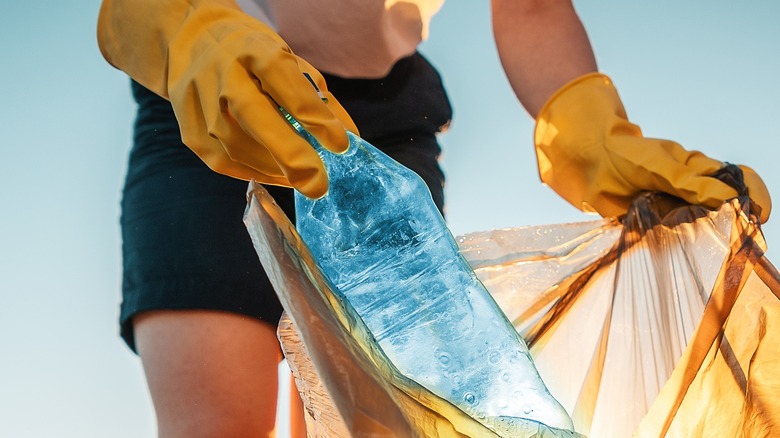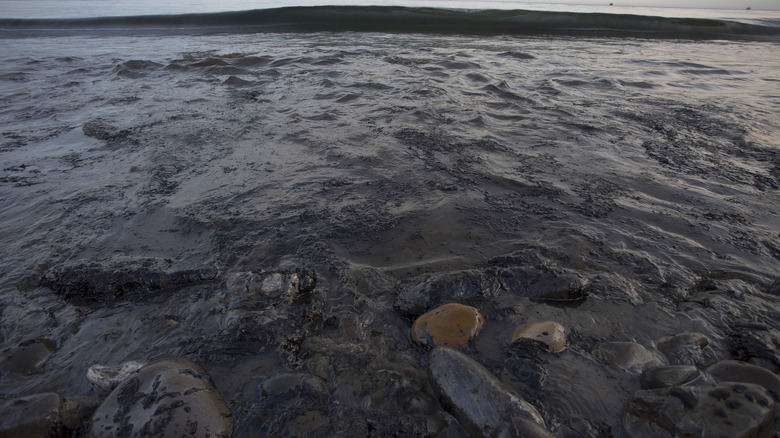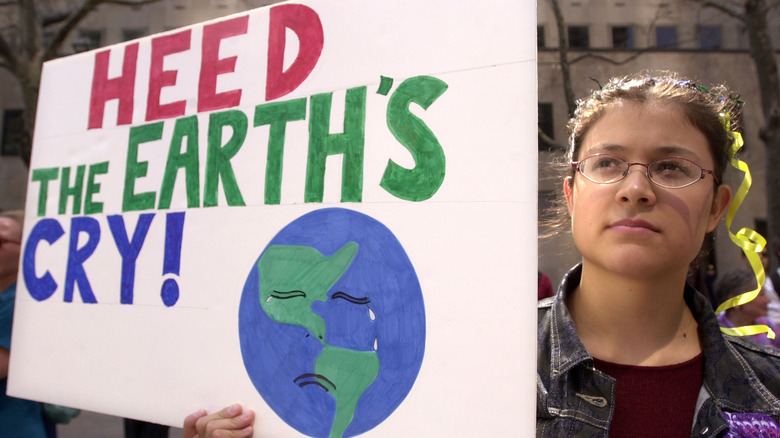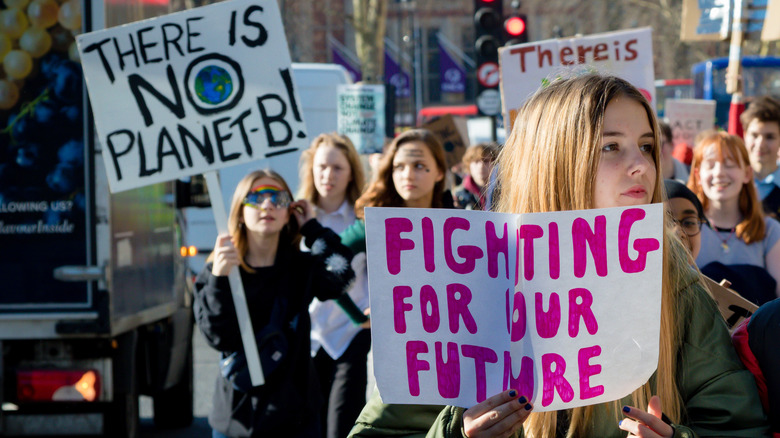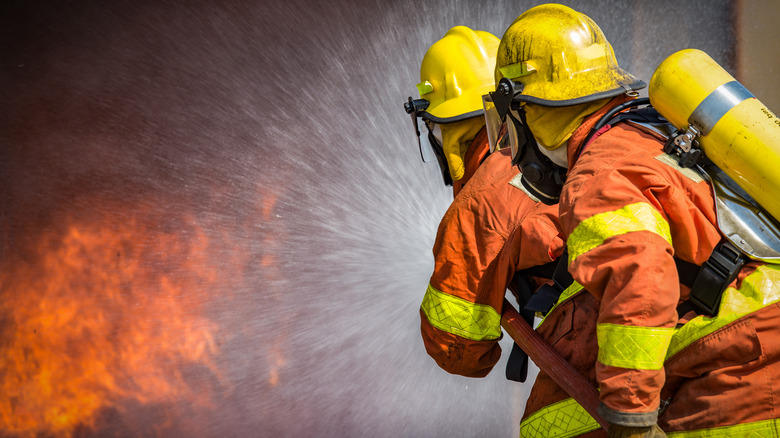What The First Earth Day In 1970 Was Like
Earth Day is the biggest non-religious holiday in the world, which more than 1 billion people celebrate each year (via Grist). But people didn't always know that humans were harming the Earth with their actions — and that's what actually kicked off the very first Earth Day.
As History reports, there was one influential book that spurned the environmental movement: the 1962 book "Silent Spring," by Rachel Carson. Per the Natural Resources Defense Council, Carson wrote a moving narrative about the harm that DDT pesticide chemicals were causing to hundreds of insect species. Not only did DDT kill off insects, but it poisoned people and other animals, and remained toxic long after it had washed from the crops and into nearby water sources. The most haunting chapter, titled "A Fable for Tomorrow," recounted an entire town that had fallen silent after all the living things had been killed by DDT.
The book was widely read and shifted the whole environmental debate. People became aware for the first time that pesticides were being used, and that they could alter the planet irrevocably. As The New York Times reports, President John F. Kennedy cited "Silent Spring" as the reason behind his directives to the federal government to examine pesticides in a new light.
DDT and deadly oil spills
In 1969, U.S. Senator Gaylord Nelson of Wisconsin boarded an airplane out of Los Angeles (via KCRW). He happened to be flying just as a massive oil spill off the coast of Santa Barbara was taking place, and Nelson had a bird's-eye view of the destruction. Nelson could see a sprawling 800-mile patch of oil leaking into the ocean. The ocean's creatures — fish, birds, and mammals alike — washed up dead on the shores en masse. With the high animal death toll and ocean waves silenced by globs of oil, horrified locals truly thought the oil spill was the end of Santa Barbara.
With these environmental factors in place, Nelson believed it was time to take meaningful action. Grist reports that Nelson was immediately supported by union leaders in the auto industry, who donated $2,000 to the cause. According to Time, lots of businesses were also quick to show their support for the initiative.
A new American campaign
The Wilderness Society (posted at Nelson Institute for Environmental Studies) reports that Earth Day founder Gaylord Nelson started the Outdoor Recreation Acquisition Program during his tenure as the governor of Wisconsin in the late 1950s. The program added $1 million to buy up land to turn into parks, and was paid for with one of the first-ever U.S. cigarette taxes. In 1962, Nelson was elected as the Senator of Wisconsin, and dedicated much of his platform to environmental change. He co-sponsored the 1964 Wilderness Act, and helped pass a 1968 bill to protect thousands of miles along the Appalachian Trail. From the earliest moments in his career, environmentalism was what Gaylord Nelson was all about.
But by 1969, Nelson was ready to apply new pressure not just to other politicians, but to all Americans (via the Nelson Institute for Environmental Studies). He wanted to inspire a dynamic grassroots movement, rather than a bland government-run holiday. And with the recent climate catastrophes fresh in people's minds, Nelson later said, "Earth Day planned itself."
Raising awareness
After months of organizing and event planning, on April 22, 1970, people of all ages gathered across the nation (via the Nelson Institute for Environmental Studies). History reports that they held educational programs and rallies to raise awareness for environmental awareness. Nelson hoped to shake Americans awake to the real and present dangers that result from inaction.
As The Library of Congress reports, across the United States, thousands of schools, colleges, and community centers held their first Earth Day events. History relates that Nelson's hope was to force everyone to think about their role in maintaining the environment. After those recent revelations around the plight of planet Earth, there was an overwhelmingly positive response from the 10,000 schools and 1,500 universities who celebrated the first Earth Day (via Time). The responses differed by location, since each town had its own environmental issues, from air pollution to water pollution to littering.
Unique festivities
According to the Encyclopedia of Cleveland History, Ohio's festivities had 500,000 participants. The citizens had good reason — the Cuyahoga River had recently caught on fire (not even for the first time) as a result of the oil that had leaked into its waters. One thousand students and teachers at Cleveland State University held a "death march" to the Cuyahoga River; one protester tried to paddle a boat in the river, but was stymied by the dense pollution. Then there was an environmental conference, which allowed local organizers to speak out about the changes they wanted to see.
College-age students in Florida held a mock trial for a Chevrolet, accusing the car brand of belching toxic smog into the air (via Time). The car "lost" the trial, and students reportedly took turns hitting it with a sledgehammer. Meanwhile, other folks hopped on their bikes to protest the overload of smoggy car emissions in Colorado. Young children participated in clean-ups, collecting bottles and cans from the shores of beaches and empty lots. In California, kids spent the day collecting used tires.
The long-term impact
Educational booths were set up in downtown Manhattan; New Yorkers scrubbed subway cars clean as they pulled into the station, while others collected trash along the banks of the East River (via Time). Fifth Avenue was shut down for the day and decorated with balloons and streamers.
History reports that Earth Day was so effective that by July of that same year, the Environmental Protection Agency was established. The Agency has since added requirements that gas-powered cars emit cleaner fumes, and improved the air quality in the United States' many national parks (via The Library of Congress). The Clean Water Act and the Endangered Species Act were also inspired by the first Earth Day (via History).
Encyclopedia of Cleveland History reports that people also became much more aware of the importance of recycling throughout the 1970s, following the first Earth Day. The first Earth Day gave rise to a whole decade of activism, called the "Environmental Decade." Overall, the first Earth Day brought out 20 million Americans. And by the 20th anniversary, 200 million people celebrated worldwide (via History). This year marks the 52nd anniversary of Earth Day, continuing the tradition of cleaning up the planet — and raising awareness of what could happen if we don't.
